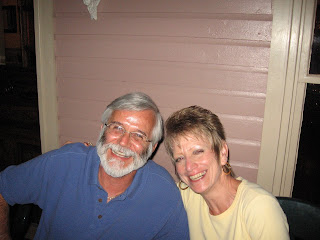 I let my hair down and did some fishing.
I let my hair down and did some fishing. Spring Creek
Spring Creek The Museum Entrance
The Museum Entrance Blacksmith shop with oxen yokes and other equipment.
Blacksmith shop with oxen yokes and other equipment. The tug used to move the logs to the sawmills.
The tug used to move the logs to the sawmills. Part of the Pioneer Village
Part of the Pioneer Village The yellow poles are part of the loader that was damaged when Mt. St. Helens erupted.
The yellow poles are part of the loader that was damaged when Mt. St. Helens erupted.We only traveled 50 miles from Crater Lake to Collier Memorial State Park near Chiloquin, OR where we decided to just kick back and spend a week. It is a nice park with paved roads and sites which is a good thing since it has not rained here in two months and it is so dry the many chipmunks running around put up a cloud of dust like a wagon train on the Oregon Trail. The weather here has been great but different from what we are used to with highs in the mid 80's but lows in the 30's, a 50 degree difference each day. A couple of days have been a little smokey from forest fires in the area including one that just started at Diamond Lake where we stayed to visit Crater Lake last week. The park is on a river and stream and I have done some fishing, but no catching. The camp host told me he has fished here for seven years and has only caught two fish, so we may have to stay here awhile if I expect to catch anything. Although, fishing is not always about catching.
Part of the park is an outdoor logging museum with a collection of antique equipment and a pioneer village with nine log cabins from points around southern Oregon. The logging equipment ranges from ox drawn wagons to a loader that was damaged when Mt. St. Helens erupted in 1980. There is even a tug that was used to move logs across Klamath Lake to the sawmills. The land for the park and the artifacts in the museum are a gift to the state from Alfred and Andrew Collier who donated them in 1945 as a memorial to their parents.
We learned this week that our Crater Lake post is going to be published on Road Trip Journal. We are getting paid $10 for that article but will also be in a Readers Choice Contest in November for a $100 gas card. One voter will also win a prize so we will be asking all friends and family members to vote early and vote often :) :)


















 M.C. Escher
M.C. Escher

















